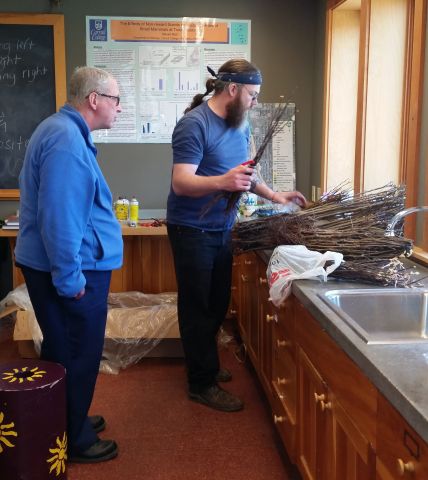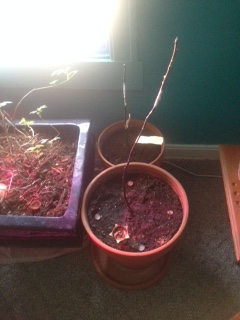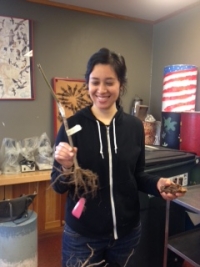This blog post was written by Brittany Dunning. Brittany has been an Urban Ecology Center volunteer for the past three years and was excited to attend the Center's Tree Grafting workshop as part of our Earth Month Series.
For centuries, people have been changing fruit trees to suit their needs, and the Center's Earth Month Series workshop allowed the opportunity for me to do it too! I chose to attend the Tree Grafting Workshop because I believe growing your own food is so important. By attending this workshop, I thought I would gain a life skill that would encourage me to grow my own food and learn to share this pleasure by grafting with other like-minded people who also want to grow their own food. While tree grafting is not a new topic at all for me (as I have been growing food and gardening for a long time) working specifically with fruit trees was very new to me in the plant kingdom.
In this class, we needed the following tools: sharp knife, root stock, scion, rubbery stretchy tape such as electrical tape or polyvinyl, grafting compound (wax, I used chapstick, which contained beeswax and olive oil). Scion is the twig or bud which will be the top of the new plant. It is best to use a scion with 3 buds on it, according to the teacher. The stock or rootstock is the root part of the plant that we grafted the scion to. A root may be a tree, as long as it has roots. Our teacher had an old saying, "Graft when the leaf of the stock is the size of a squirrels ear." The inner cambium part is important to know as well when grafting, which is a type of cell that forms a layer between the bark and the wood. It is important to get these matched up between the scion and root when grafting.

We made sure that the scion and the root were of similar diameter so that the cambium layer would match up properly; a proper fit will allow for a successful grafting. Then we shaped the end of the scion into a wedge using a sharp knife, which looked similar to a flathead screwdriver. We then made a horizontal cut into the top of the rootstock and placed the scion into the split of the root we cut. When it fit in there snug we applied a couple layers of tape around the two. Upon reaching home we were told to cover the area in wax in order to maintain moisture for proper growth.
 A specific take-away from this tree grafting workshop is that it's a community affair. Yes you can have one tree that you have grafted, but the real joy will come in sharing with others in the community. Trading scions of various fruits with friends and neighbors will be so fun, not to mention enabling a delicious variety of fruit to be had from one tree.
A specific take-away from this tree grafting workshop is that it's a community affair. Yes you can have one tree that you have grafted, but the real joy will come in sharing with others in the community. Trading scions of various fruits with friends and neighbors will be so fun, not to mention enabling a delicious variety of fruit to be had from one tree.
I look forward to watching my Luscious Pear scion grow on the Quince rootstock which I grafted them to. In two years I will have two wonderful fruit bearing dwarf size trees! These will get as tall as an average adult (maybe a little larger). Perfect for any home in an urban or rural setting!
Want to get involved?
There's still time to take part in the Urban Ecology Center's Earth Month activities! We have workshops, service projects and events going on through the month of April, so there's bound to be something that fits your fancy.
Many thanks to our Earth Month sponsors!






